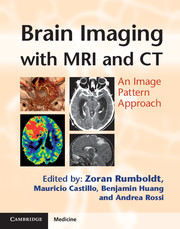Book contents
- Frontmatter
- Contents
- List of contributors
- List of abbreviations
- Preface
- Section 1 Bilateral Predominantly Symmetric Abnormalities
- Section 2 Sellar, Perisellar and Midline Lesions
- 38 Rathke's Cleft Cyst
- 39 Pituitary Microadenoma
- 40 Lymphocytic Hypophysitis
- 41 Pituitary Macroadenoma
- 42 Ectopic Posterior Pituitary Lobe
- 43 Langerhans Cell Histiocytosis
- 44 Craniopharyngioma
- 45 Hypothalamic Hamartoma
- 46 Optic Glioma
- 47 Perisellar Meningioma
- 48 Hemangioma of the Cavernous Sinus
- 49 Tolosa–Hunt Syndrome
- 50 Carotid-Cavernous Sinus Fistula
- 51 Perisellar Aneurysm
- 52 Chordoma
- 53 Chondrosarcoma
- 54 Colloid Cyst
- 55 Aqueductal Stenosis
- 56 Progressive Supranuclear Palsy (PSP)
- 57 Joubert Syndrome
- 58 Rhombencephalosynapsis
- 59 Multiple System Atrophy (MSA)
- 60 Maple Syrup Urine Disease (MSUD)
- 61 Chiari 2 Malformation
- 62 Tectal Glioma
- 63 Brainstem Glioma
- 64 Duret Hemorrhage
- 65 Hypertrophic Olivary Degeneration
- 66 Osmotic Myelinolysis
- 67 Germinoma
- 68 Pineoblastoma
- 69 Pineal Cyst
- 70 Vein of Galen Aneurysmal Malformation (VGAM)
- 71 Corpus Callosum Dysgenesis
- 72 Septo-Optic Dysplasia
- 73 Holoprosencephaly
- 74 Atretic Parietal Encephalocele
- 75 Dermoid Cyst
- 76 Lipoma
- Section 3 Parenchymal Defects or Abnormal Volume
- Section 4 Abnormalities Without Significant Mass Effect
- Section 5 Primarily Extra-Axial Focal Space-Occupying Lesions
- Section 6 Primarily Intra-Axial Masses
- Section 7 Intracranial Calcifications
- Index
- References
75 - Dermoid Cyst
from Section 2 - Sellar, Perisellar and Midline Lesions
Published online by Cambridge University Press: 05 August 2013
- Frontmatter
- Contents
- List of contributors
- List of abbreviations
- Preface
- Section 1 Bilateral Predominantly Symmetric Abnormalities
- Section 2 Sellar, Perisellar and Midline Lesions
- 38 Rathke's Cleft Cyst
- 39 Pituitary Microadenoma
- 40 Lymphocytic Hypophysitis
- 41 Pituitary Macroadenoma
- 42 Ectopic Posterior Pituitary Lobe
- 43 Langerhans Cell Histiocytosis
- 44 Craniopharyngioma
- 45 Hypothalamic Hamartoma
- 46 Optic Glioma
- 47 Perisellar Meningioma
- 48 Hemangioma of the Cavernous Sinus
- 49 Tolosa–Hunt Syndrome
- 50 Carotid-Cavernous Sinus Fistula
- 51 Perisellar Aneurysm
- 52 Chordoma
- 53 Chondrosarcoma
- 54 Colloid Cyst
- 55 Aqueductal Stenosis
- 56 Progressive Supranuclear Palsy (PSP)
- 57 Joubert Syndrome
- 58 Rhombencephalosynapsis
- 59 Multiple System Atrophy (MSA)
- 60 Maple Syrup Urine Disease (MSUD)
- 61 Chiari 2 Malformation
- 62 Tectal Glioma
- 63 Brainstem Glioma
- 64 Duret Hemorrhage
- 65 Hypertrophic Olivary Degeneration
- 66 Osmotic Myelinolysis
- 67 Germinoma
- 68 Pineoblastoma
- 69 Pineal Cyst
- 70 Vein of Galen Aneurysmal Malformation (VGAM)
- 71 Corpus Callosum Dysgenesis
- 72 Septo-Optic Dysplasia
- 73 Holoprosencephaly
- 74 Atretic Parietal Encephalocele
- 75 Dermoid Cyst
- 76 Lipoma
- Section 3 Parenchymal Defects or Abnormal Volume
- Section 4 Abnormalities Without Significant Mass Effect
- Section 5 Primarily Extra-Axial Focal Space-Occupying Lesions
- Section 6 Primarily Intra-Axial Masses
- Section 7 Intracranial Calcifications
- Index
- References
Summary
Specific Imaging Findings
Intracranial dermoid cysts usually occur at or near the midline, most frequently in a parasellar, frontonasal, or posterior fossa location. Frontonasal and posterior fossa dermoids may be associated with a dermal sinus tract. The cysts usually follow imaging characteristics of fat, being typically hypodense on CT and T1 hyperintense. The capsule of the cyst frequently contains calcification. There is no contrast enhancement. Some dermoids may contain teeth (easily identified on CT) or hair which may appear as thin, curvilinear, low-signal intensity structures on T2-weighted images. If dermoid cysts rupture the fat droplets scatter throughout the subarachnoid spaces and in severe cases fat-fluid levels may be present within the ventricles. Post-contrast imaging may show extensive leptomeningeal enhancement when leakage of cyst contents leads to chemical meningitis. CT hyperdense dermoid cysts are very rare and occur exclusively in the posterior fossa.
Pertinent Clinical Information
Dermoids are uncommon, representing only about 0.5% of intracranial tumors. Clinical presentation is usually during the third decade of life with headaches, seizures, or symptoms related to compression of adjacent tissues (e.g. visual changes from optic chiasm compression); however, they are often asymptomatic. Cyst rupture may cause aseptic meningitis, seizure, ischemic symptoms and infarctions secondary to vasospasm, as well as acute hydrocephalus. Cyst rupture is actually more common than previously thought and it may also cause only minimal symptoms or be even completely asymptomatic. The goal of treatment is surgical removal of the cyst, although adherence of the cyst capsule to the nearby neurovascular structures may preclude complete resection. Nevertheless, dermoids are overall less likely to recur than epidermoid tumors.
Information
- Type
- Chapter
- Information
- Brain Imaging with MRI and CTAn Image Pattern Approach, pp. 153 - 154Publisher: Cambridge University PressPrint publication year: 2012
References
Accessibility standard: Unknown
Why this information is here
This section outlines the accessibility features of this content - including support for screen readers, full keyboard navigation and high-contrast display options. This may not be relevant for you.Accessibility Information
- 1
- Cited by
